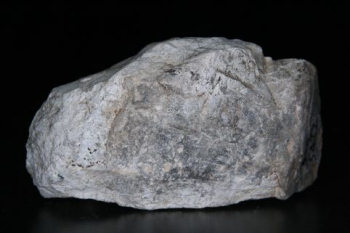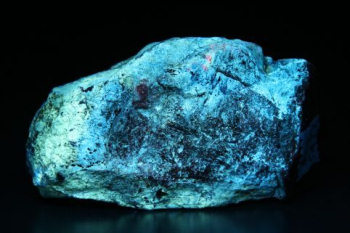Database of luminescent minerals
DIOPSIDE
Chemical formula: CaMgSi2O6
Family: Silicates
Status: IMA-A
Crystal system : Monoclinic
Display mineral: NON
Luminescence:
Longwave UV (365nm) colors: |
Blue , | ||
Intensity LW:Weak | |||
Shortwave UV (254nm) colors: |
Blue , Bluish White , Greenish Blue , sky-blue , | ||
Intensity SW:Strong | |||
Daylight picture

DIOPSIDE, Stockton Mining District, Tooele, Utah, USA
Photo and Copyright: James Horste
Used with permission of the author.
Shortwave (254nm) picture

DIOPSIDE UVSW, Stockton Mining District, Tooele, Utah, USA
Photo and Copyright: James Horste
Used with permission of the author.
Do you have a photo of this mineral you would like to see in the gallery? Contact us!
Phosphorescence (in the common sense of the term) observable with the naked eye:
No data
Comments:
Variety fassaite : white SW and LW;(Fassaite is now associated with augite but sometime described a diopside variety in the 19th publication)
Associated as grain (fluo blue SW) in wernerite (fluo orange LW) in Canada.
Associated with NORBERGITE (fluo Yellow SW) in Franklin, New jersey, USA;
Activator(s) and spectrum:
Activator(s): n[TiO6] cluster, Cr3+, Fe3+, Mn2+ , Nd3+,
Peaks in the spectrum (nm):
[TiOn]m-: 450nm band, 520nm
Mn2+II repl. Ca2+: 580 - 585 - 586nm
Mn2+I repl. Mg2+: 690nm (Franklin, USA exc. 532nm)
Fe3+ : 758nm (Otter Lake, Canada, exc. 532nm)
Cr3+ repl. Mg2+?: 684, 705, 860nm
Cr3+ : broad band at 785nm connected to Cr3+ center in weak crystal field (decay time of 5 μs)
Cr3+ in average crystal field or to V2+ : broad structured band peaking at approximately 700 nm with peaks at 679, 685, 700, 722nm (V2+) (sample from Tyrol, exc. 532nm)
(?) : 670nm (sample from Fassathal, Tyrol, exc. 532nm)
Nd3+ : 874, 891, 916nm (Otter Lake, Canada, exc. 780nm)
No spectrum yet
Comments on spectrum and activators:
Natural diopside displays a large variety of luminescence centers: at room temperature main features are a 450 nm band, that can be ascribed to the TiO6 complex, an intense bands at 585 and 690 nm that can be ascribed to Mn2+ ions in M2 (Ca2+) and M1 (Mg2+) sites, lines near 684 nm belonging to Cr3+ and band peaking at 690 nm ascribed to Fe3+ (Gorobets and Rogojine 2001).
Best localities for fluorescence (*):
- Franklin Quarry, Franklin Marble, Franklin, Franklin Mining District, Sussex Co., New Jersey, USA;
- Farber Quarry, Franklin, New jersey, USA; Sparta, New Jersey, USA;
- Limecrest Quarry, Sparta Township, Sussex Co., New Jersey, USA;
- Lake Valhalla Quarry, Montville Township, Morris Co., New Jersey, USA;
- Ilimaussaq complex, Kvanefjeld, Narsaq, Kitaa (West Greenland) Province, Greenland;
- Zinc Corp. of America, mine 4, Balmat, St Lawrence County, New York, USA;
- State Route 28N roadcut, Newcomb Township, Essex Co., New York, USA;
- Amity, Town of Warwick, Orange Co., New York, USA (bright white SW);
- Fort Ann, Washington Co., New York, USA;
- Edwards, Balmat-Edwards Zinc District, St. Lawrence Co., New York, USA;
- H.T. Campbell Quarry, Texas, Baltimore Co., Maryland, USA;
- Long Lake Zinc Mine, Parham, Ontario, Canada (Diopside fl. SW cream to blue-white + calcite fl. SW red + humite fl. SW yellow + chondrodite fl. SW yellow);
- Jeffrey Mine (Johns-Manville Mine), Asbestos, Les Sources RCM, Estrie, Québec, Canada (intense fluo SW+LW, associated with yellow-green to violet Vesuvianite);
- Merelani Hills, Lelatema Mts, Simanjiro District, Manyara Region, Tanzania (Fluo SW, dull fluo LW);
- Gföhl, Waldviertel, Lower Austria, Austria (blue SW);
(*)The data are not exhaustive and are limited to a few remarkable localities for fluorescence
Bibliographic reference for luminescence:
- The Henkel Glossary of Fluorescent Minerals, Dr. Gerhard Henkel, Published by the FMS, 1989 ,
- Fluorescence: Gems and Minerals Under Ultraviolet Light, Manuel Robbins, 1994, Geoscience Press, ISBN 0-945005-13-X ,
- The World of Fluorescent Minerals, Stuart Schneider, Schiffer Publishing, 2006, ISBN 0-7643-2544-2 ,
- Luminescence Spectroscopy of Minerals and Materials, M. Gaft, R. Reisfeld, G. Panczer, Springer Editor, ISBN: 10 3-540-21918-8 ,
- Luminescent Spectra of Minerals, Boris S. Gorobets and Alexandre A. Rogojine, Moscow, 2002 ,
Reference for luminescence on the Internet:
Images:
- Franklin, USA: http://www.mindat.org/photo-268138.html
- Franklin, USA: http://www.mindat.org/photo-673439.html
- Franklin, USA: http://www.mindat.org/photo-673439.html
- Franklin Quarry, USA: http://www.mindat.org/photo-629908.html
- Long Lake Zinc Mine, Ontario, Canada: http://www.mindat.org/photo-223439.html
- State Route 28N roadcut, Newcomb USA: http://www.mindat.org/photo-350496.html
- State Route 28N roadcut, Newcomb USA: http://www.mindat.org/photo-350503.html
- State Route 28N roadcut, Newcomb USA: http://www.mindat.org/photo-350500.html
- Lake Valhalla Quarry, New Jersey, USA: http://www.mindat.org/photo-573253.html
- Fort Ann, Washington Co., New York, USA: http://www.mindat.org/photo-602677.html
- Fort Ann, Washington Co., New York, USA: http://www.mindat.org/photo-664958.html
- Edwards, Balmat-Edwards Zinc District, USA: http://www.mindat.org/photo-618897.html
- Edwards, Balmat-Edwards Zinc District, USA: http://www.mindat.org/photo-627377.html
- H.T. Campbell Quarry, Maryland, USA: http://www.mindat.org/photo-638520.html
Mineralogical reference on the Internet:
 http://www.mindat.org/show.php?name=Diopside
http://www.mindat.org/show.php?name=Diopside
 http://webmineral.com/data/Diopside.shtml
http://webmineral.com/data/Diopside.shtml
Internet Search:
 Image search on 'Google Images'
Image search on 'Google Images'
 Search for documents in all languages on Google
Search for documents in all languages on Google
A request providing no result means only that no such reference exists in the database, but it does not mean that what you are looking for does not exist, just not to our knowledge. If you think you have found an error or omission, please let us know via the contact page being sure to cite the source of information.
